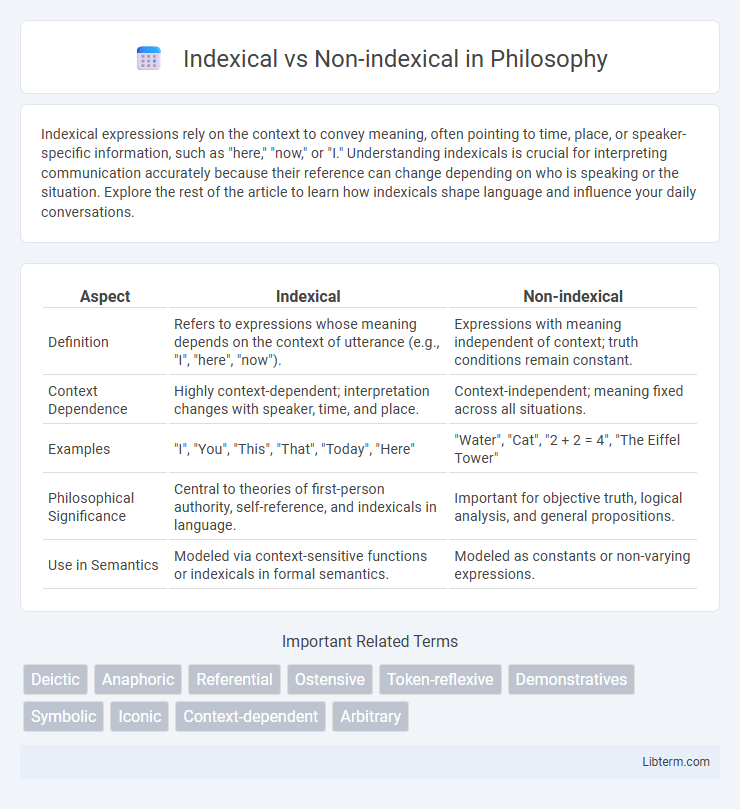Indexical expressions rely on the context to convey meaning, often pointing to time, place, or speaker-specific information, such as "here," "now," or "I." Understanding indexicals is crucial for interpreting communication accurately because their reference can change depending on who is speaking or the situation. Explore the rest of the article to learn how indexicals shape language and influence your daily conversations.
Table of Comparison
| Aspect | Indexical | Non-indexical |
|---|---|---|
| Definition | Refers to expressions whose meaning depends on the context of utterance (e.g., "I", "here", "now"). | Expressions with meaning independent of context; truth conditions remain constant. |
| Context Dependence | Highly context-dependent; interpretation changes with speaker, time, and place. | Context-independent; meaning fixed across all situations. |
| Examples | "I", "You", "This", "That", "Today", "Here" | "Water", "Cat", "2 + 2 = 4", "The Eiffel Tower" |
| Philosophical Significance | Central to theories of first-person authority, self-reference, and indexicals in language. | Important for objective truth, logical analysis, and general propositions. |
| Use in Semantics | Modeled via context-sensitive functions or indexicals in formal semantics. | Modeled as constants or non-varying expressions. |
Understanding Indexical and Non-indexical: A Brief Overview
Indexical expressions directly reference contextual elements such as time, place, or speaker, making their meaning dependent on the situation, like "here," "now," or "I." Non-indexical expressions carry stable meanings that remain constant regardless of context, such as "water" or "seven." Understanding the distinction between indexical and non-indexical terms is crucial for parsing meaning in language, philosophy, and semantics.
Defining Indexical Signs: Meaning and Characteristics
Indexical signs directly point to or indicate their referent through a physical or causal connection, such as smoke indicating fire or a clock showing time. Their meaning is context-dependent and relies on the presence or occurrence of something in the real world, distinguishing them from non-indexical signs that represent through arbitrary or conventional symbols. Characteristics of indexical signs include their inherent link to the referent and the necessity of contextual interpretation for accurate understanding.
Non-indexical Signs: Concept and Examples
Non-indexical signs, also known as symbols, represent their objects through arbitrary or conventional associations rather than direct physical or causal connections. Examples of non-indexical signs include letters in the alphabet, mathematical symbols, and national flags, all of which rely on shared cultural understanding for interpretation. These signs are fundamental in language development, allowing abstract ideas to be communicated effectively across different contexts.
Historical Development of Indexicality in Semiotics
Indexicality in semiotics has evolved from Charles Sanders Peirce's foundational triadic model, where indexicals are signs directly connected to their objects by causality or physical presence. Historically, the development of indexical theory emphasized the contextual and pragmatic dimensions of meaning, distinguishing indexicals from iconic and symbolic signs through their reliance on spatiotemporal and situational factors. Modern semiotics expands on this by exploring indexicality in language, gesture, and media, underscoring the dynamic interaction between signs and their referents within communicative contexts.
Key Differences Between Indexical and Non-indexical Signs
Indexical signs have a direct, causal or physical connection to their referents, such as smoke indicating fire, whereas non-indexical signs rely on arbitrary or conventional relationships, like written words representing objects or ideas. Indexicals are context-dependent and their meaning changes with time or place, while non-indexical signs maintain consistent meaning regardless of context. Understanding these key differences is crucial in semiotics, communication theory, and linguistic analysis.
Real-world Applications: Indexical vs Non-indexical in Language
Indexical expressions such as "here," "now," and "I" rely on context to determine their meaning and are crucial in natural language processing applications like chatbots and virtual assistants for accurate interpretation of user intent. Non-indexical expressions have fixed references independent of context, enabling consistent information retrieval and search engine optimization. Understanding the distinction between indexical and non-indexical language enhances machine translation systems by improving contextual awareness and semantic disambiguation.
Indexicality in Visual Communication and Media
Indexicality in visual communication and media refers to signs that have a direct, physical connection to their referents, such as photographs or footprints, which convey meaning through a causal or factual relationship. Indexical signs are crucial for establishing authenticity and credibility in media, as they provide evidence-based representation of events or objects. Understanding indexicality enhances interpretation by emphasizing the direct link between the visual sign and the reality it signifies, differentiating it from non-indexical signs that rely on symbolic or conventional meanings.
Non-indexical References in Digital Content and Technology
Non-indexical references in digital content and technology refer to entities or concepts that maintain consistent meaning regardless of context or user perspective, ensuring clear and unambiguous communication across platforms. Semantic web technologies utilize non-indexical terms and URIs to enable interoperable data exchange, enhancing machine readability and content discoverability. This stability supports improved search engine optimization (SEO) and reliable metadata tagging, driving efficient content retrieval and user engagement.
Challenges in Interpreting Indexical and Non-indexical Signs
Interpreting indexical signs poses challenges due to their dependence on context, requiring accurate identification of time, place, or situation to derive meaning effectively. Non-indexical signs, while more stable in reference, can present ambiguity through symbolic or conventional meanings that vary across cultures or contexts. Both types demand careful analysis to avoid misinterpretation, especially in dynamic communication environments where context and conventions shift rapidly.
Future Trends in Indexical and Non-indexical Studies
Future trends in indexical and non-indexical studies emphasize the integration of advanced natural language processing (NLP) techniques to enhance contextual interpretation and meaning disambiguation. Researchers are increasingly leveraging machine learning models to differentiate indexical expressions, such as pronouns and deictic terms, from non-indexical expressions with static reference, aiming to improve semantic understanding in AI conversational agents. The development of dynamic semantics and pragmatic inference frameworks promises to revolutionize the ability of systems to accurately interpret context-dependent language across diverse communication settings.
Indexical Infographic

 libterm.com
libterm.com